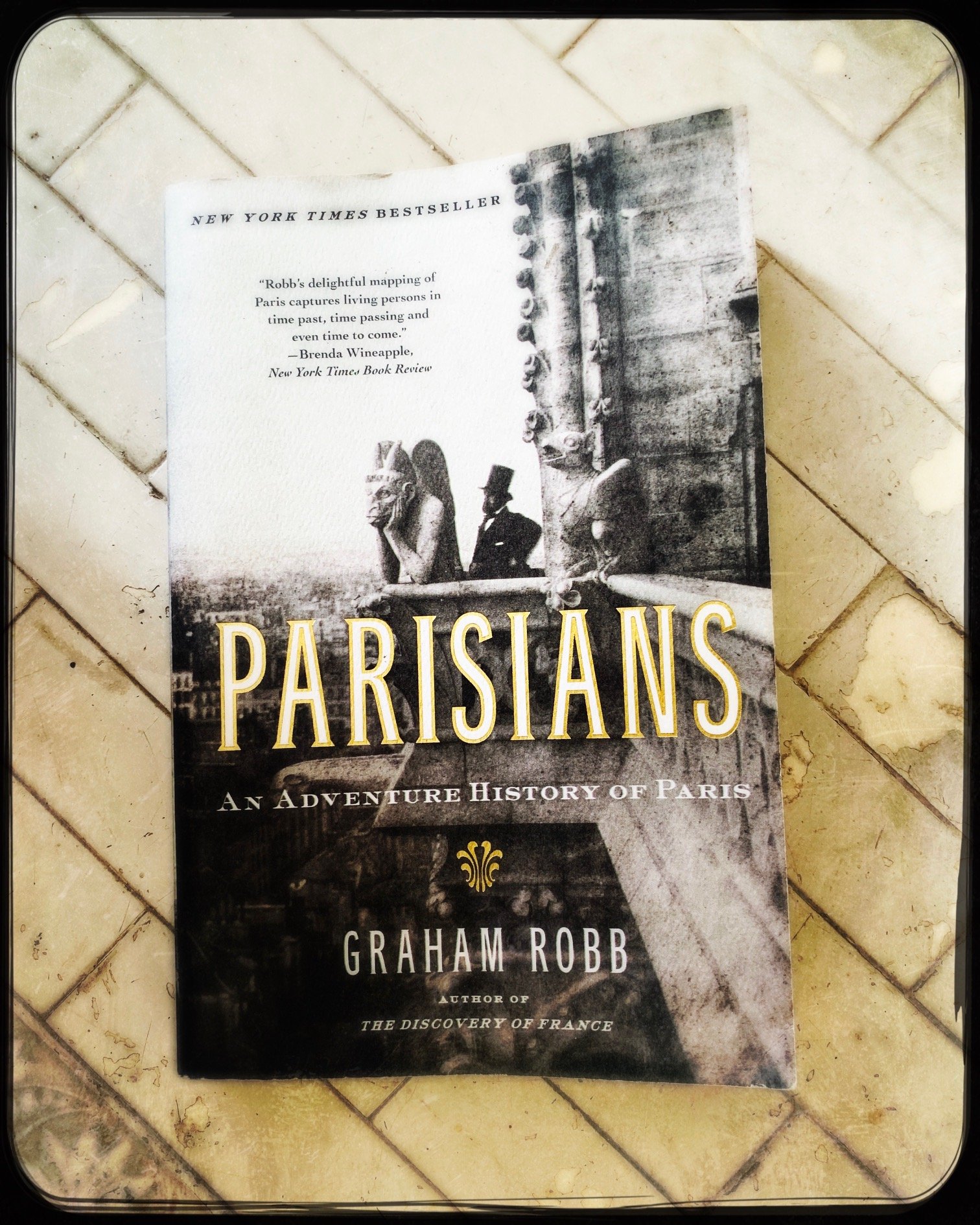Paris Bookstack
Jules X
Read these books alongside a romp through “Literary Paris” or from afar—Paris is a state of mind, accessible via an in-person tour or through its rich literature that can be read everywhere.
There are more than thousands of books about Paris. This selection of six gives just a small taste of the literary city and its evergreen inspiration to writers across time. Photograph by Madrigalit
PARISIANS by Graham Robb (Norton, 2010)
Sub-titled “An Adventure History of Paris,” Graham Robb’s Parisians is a delightful collection of unique and meticulously detailed stories from the city’s layered history, focusing primarily from after the seventeenth century. Exploring Paris after reading Robb, one feels the holder of various secrets, secrets that emerge upon viewing such spaces as the Palais-Royal or the Church of Saint-Germain-des-Prés. These venues, writ large in history and slathered in many a tourist’s guidebook, become the scenes of wonderful historical moments, shared in the smart and lively prose of Robb’s book.
Graham Robb’s Parisians brings the history of Paris to life. Photograph by Madrigalit
LOST ILLUSIONS by Honoré de Balzac; translated by Raymond N. MacKenzie (University of Minnesota Press, 2020)
According to the English writer Oscar Wilde, “the nineteenth century, as we know it, is largely an invention of Balzac.” This is primarily because of French author’s multivolume masterpiece The Human Comedy (La Comédie Humaine), which details, in Balzac’s marvelously quippy and nuanced prose, French society in the 1820s and 1830s. While toting these several books to Paris might be unrealistic—I suggest a shelf of them behind one’s desk at home—an enthusiastic reader might consider Lost Illusions, one of the more popular novels within the greater oeuvre (though the translation featured here still tracks at 554 pages, so still some extra weight for the suitcase!). Though Lost Illusions describes a newly modernizing Paris, many of its sentiments about ambition, privilege, and corruption will ring true to, if not bong loudly in the ears of, contemporary readers.
A new translation of Honoré de Balzac’s classic is just the starting point for diving into his multivolume French universe of The Human Comedy (La Comédie Humaine). Photograph by Madrigalit
ILLUMINATIONS by Arthur Rimbaud; translated by John Ashbery (Norton, 2011)
In Paris, one can read Arthur Rimbaud’s The Drunken Boat (Le Bateau Ivre) on the side of a building in the sixth arrondissement. To complement that experience, I recommend the poet’s later-published volume Illuminations for its prismatic frenzy of prose poems describing modern life. It is nearly impossible to read such poems as “Cities” and “Metropolitan” without conjuring the state of a newly chaotic urban city like Paris in Rimbaud’s time and, quite possibly, in our own. John Ashbery’s translation is not necessarily my favorite of this text, but it is fascinating to read a post-modern poet’s interpretation of the hauntingly modern Rimbaud.
Arthur Rimbaud’s “intense and rapid dreams” continue, as John Ashbury writes, “emitting pulses.” Photograph by Madrigalit
MONSIEUR PROUST by Céleste Albaret; translated by Barbara Bray (The New York Review of Books, 1976)
This recounting of the last eight years of Marcel Proust’s life—the period in which he kept largely to his home and wrote his great masterpiece, In Search of Lost Time (À la Recherche du Temps Perdu)—is tenderly and unsentimentally rendered by his housekeeper of that time, Céleste Albaret. The book reads like another volume of Proust’s magnum opus, and will serve well any biographer looking for a more intimate account of the writer. However, what is especially lovely about this story is the delicate exchange between maid and master, and the power given, in the end, to Albaret to tell it.
Madame Albaret provides an intimate and human portrayal of the great French writer. Photograph by Madrigalit
THE AUTOBIOGRAPHY OF ALICE B. TOKLAS by Gertrude Stein (Penguin Press, 2020)
This unique work, wherein Gertrude Stein assumes the narrative of her life partner, Alice B. Toklas, is not just a modern masterpiece: it is a testament to life in Paris in the early-to-mid twentieth century—and the lives of two extraordinary women. In the pages of this book, the couple encounter such artistic luminaries of the era as Guillaume Apollinaire, Henri Matisse, and Pablo Picasso. Though criticized in its time by some as too commercial or gossipy, Stein’s masterpiece remains an engaging and accessible read, in part due to Toklas’s unique narrative and perspective. This edition, decorated with the jubilant illustrations of Maira Kalman, is an especially enjoyable means by which to indulge in Stein and Toklas’s story.
A new edition of Gertrude Stein’s modern masterpiece is published with vibrant illustrations by Maira Kalman. Photograph by Madrigalit
GIOVANNI’S ROOM by James Baldwin (Vintage, 2013)
Moving forward in time, this resplendent love story is set in Paris in the 1950s, a period when the city was filled with American expatriates, including James Baldwin, who had come to the French capital in 1948, in part to escape the rampant prejudices in his own country. Populated with the city’s butcher shops, cafés, and night clubs, Giovanni’s Room makes Paris a central character in this tale of one man’s burgeoning and complicated love for another, told in Baldwin’s profoundly probing, poetic, and heartfelt prose.
James Baldwin reveals the complexities and excruciations of the human heart in Giovanni’s Room. Photograph by Madrigalit







